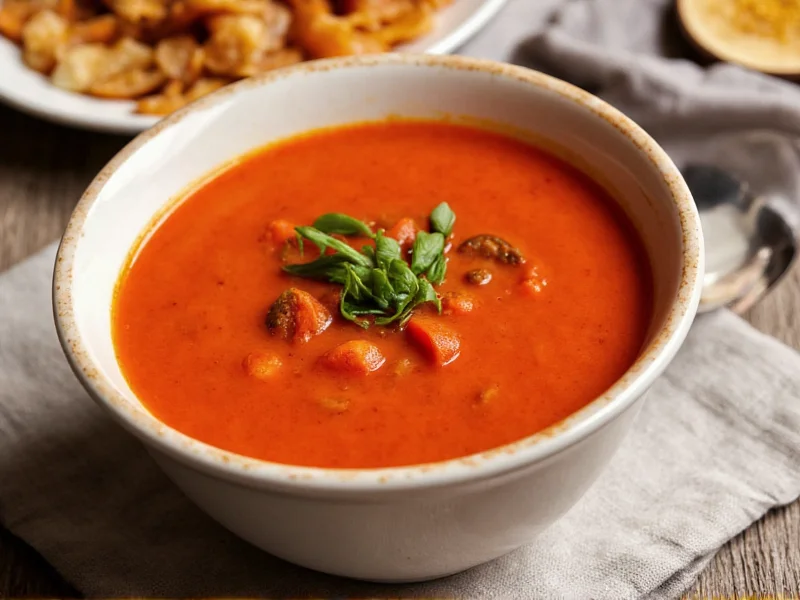Understanding the calorie content of tomato soup is essential for making informed dietary choices. Whether you're monitoring your intake for weight management or general health, knowing exactly what's in your bowl matters. This guide provides accurate, science-based information about tomato soup calories across different preparation methods and brands.
Tomato Soup Calorie Breakdown by Type
The calorie count in tomato soup varies significantly based on preparation method, ingredients, and serving size. Below is a detailed comparison of common tomato soup varieties:
| Soup Type | Serving Size | Calories | Key Ingredients Affecting Calories |
|---|---|---|---|
| Standard Canned (e.g., Campbell's) | 1 cup (245g) | 170-200 | Tomato puree, sugar, vegetable oil |
| "Healthy" Canned (low-sodium) | 1 cup (245g) | 90-120 | Reduced sugar, no added fats |
| Homemade (basic recipe) | 1 cup (240ml) | 90-150 | Fresh tomatoes, minimal oil, no cream |
| Cream of Tomato Soup | 1 cup (245g) | 220-280 | Heavy cream, butter, cheese |
| Restaurant Serving | 1.5-2 cups | 250-400 | Larger portions, added fats, bread |
Factors That Impact Tomato Soup Calorie Count
Several variables affect the final calorie content of tomato soup, making it essential to understand what influences these numbers:
Ingredients Matter Most
The addition of cream, cheese, or olive oil significantly increases calorie density. A basic tomato soup made with just tomatoes, onions, and minimal oil contains around 90 calories per cup. However, adding just 2 tablespoons of heavy cream boosts the count by approximately 100 calories. Many commercial brands include sugar (8-12g per serving) which adds 30-50 calories per cup.
Serving Size Reality Check
What constitutes a "serving" varies dramatically. Canned soup labels typically define a serving as 1 cup (245g), but many people consume the entire can (about 2 cups) in one sitting. Restaurant portions often range from 1.5 to 2 cups, effectively doubling the calorie count you might expect from standard nutritional information.
Brand Comparison Insights
Not all canned tomato soups are created equal. Major brands show significant variation:
- Traditional canned varieties: 170-200 calories per cup
- "Light" or "healthy" versions: 90-120 calories per cup
- Organic brands: 130-160 calories per cup (often less sugar)
- Premium grocery store brands: 150-180 calories per cup
Nutritional Value Beyond Calories
While monitoring calories is important, tomato soup offers valuable nutrients that contribute to its overall health profile:
Lycopene Powerhouse
Cooked tomatoes contain higher levels of lycopene, a powerful antioxidant associated with reduced risk of heart disease and certain cancers. The heat from cooking breaks down cell walls, making lycopene more bioavailable. Interestingly, the small amount of fat typically added to tomato soup (like olive oil) enhances lycopene absorption.
Vitamin and Mineral Content
A standard cup of tomato soup provides approximately:
- 40% of daily vitamin C needs
- 25% of daily vitamin A requirements
- 15% of recommended potassium intake
- Significant amounts of vitamin K and folate
Smart Strategies for Lower-Calorie Tomato Soup
If you're watching your calorie intake but love tomato soup, consider these practical approaches:
Reading Nutrition Labels Effectively
When selecting canned options, focus on these label elements:
- Check the serving size versus what you'll actually eat
- Look for versions with less than 5g of sugar per serving
- Choose options with 3g or less of fat per serving
- Verify sodium content (aim for under 480mg per serving)
Simple Homemade Recipe
Creating low-calorie tomato soup at home gives you complete control. Try this basic recipe:
- Sauté 1 chopped onion and 2 minced garlic cloves in 1 tsp olive oil
- Add 2 lbs fresh tomatoes (or one 28-oz can no-salt-added tomatoes)
- Include 1 cup vegetable broth and herbs (basil, oregano)
- Simmer 20 minutes, then blend until smooth
- Optional: Add 2 tbsp tomato paste for richer flavor without extra calories
This recipe yields approximately 100 calories per cup without compromising flavor.
Tomato Soup in Dietary Context
Understanding how tomato soup fits into your overall nutrition plan is crucial. For most adults following a 2,000-calorie diet:
- A standard serving represents 8-10% of daily calorie needs
- It can serve as a satisfying, nutrient-dense starter to meals
- Pair with a protein source (like grilled chicken) for balanced nutrition
- Consider it a vegetable serving (counts toward daily vegetable goals)
Research shows that soup consumption can increase satiety and reduce overall calorie intake during meals. A study published in the journal Appetite found that eating a low-calorie soup before a meal reduced total calorie consumption by 20% compared to the same meal without soup.











 浙公网安备
33010002000092号
浙公网安备
33010002000092号 浙B2-20120091-4
浙B2-20120091-4